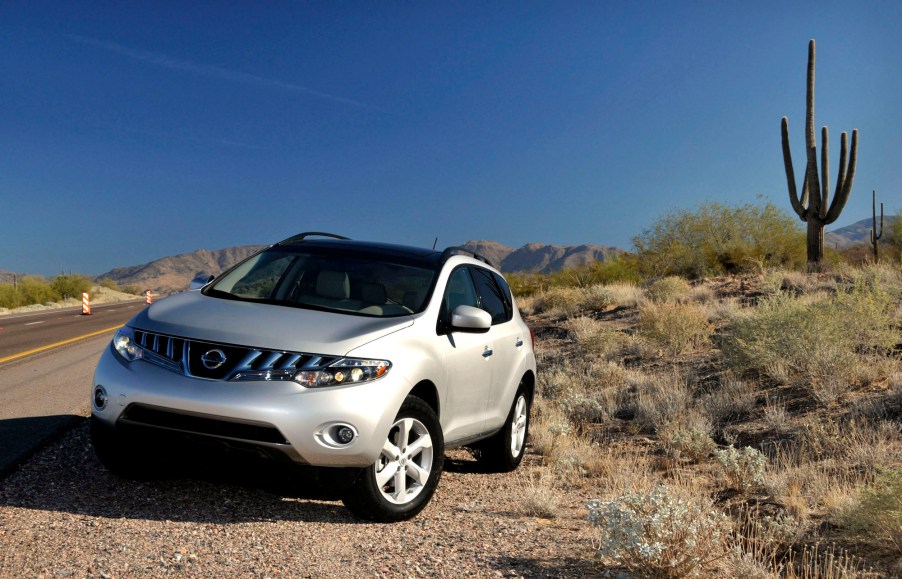
The 2009 Nissan Murano Has a Mountain of NHTSA Complaints About Brakes
Now in its third generation, the Nissan Murano debuted in May 2002 for the 2003 model year. It was Nissan’s first midsize crossover SUV for American consumers, sharing the same platform with the third-generation Altima. The latest model has received good reviews and appears dependable. But the 2009 Nissan Murano has amassed a mountain of complaints about its brakes.
The NHTSA’s 230 owner complaints about the 2009 Nissan Murano’s brakes
The National Highway Traffic Safety Administration has received more than 230 complaints about the 2009 Nissan Murano’s brakes, CarComplaints.com reports. Among the top grievances, drivers reported that although the Murano’s brakes engage, it feels like they’re not. This might result in over-braking. Another major gripe is that drivers must press the brake pedal to the floor to stop the vehicle. After drivers reported 14 accidents and several non-life-threatening injuries, the NHTSA opened an investigation concerning the 2009 Murano’s faulty anti-lock braking system in April 2018.
And in February 2019, Nissan was forced to recall over 86,000 2009 Murano SUVs for a potentially defective ABS part.
CarComplaints.com rates this problem a 10 for severity, or “Really Awful.” This rating seems to involve not only the brake issues but also Nissan’s handling of the situation. In one of the most recent complaints, in July 2020, an owner wrote that a year after Nissan fixed the issue per the recall, “the same exact problem occurred, and Nissan says we are now responsible for the bill because they only have to attempt to fix recalls once.”
Also, a 2019 complaint stated that “the vehicle failed a state safety inspection due to brake pedal being depressed to the floorboard without warning.” After taking the vehicle to an independent mechanic who replaced the brake master cylinder, the 2009 Nissan Murano failed a second state inspection.
Another common complaint involves the 2009 Murano’s brake pressure. It loses brake pressure when hitting bumps, traveling on uneven surfaces, or driving over utility hole covers.
Understanding common ABS problems
If the anti-lock brake hydraulic control unit fails, a vehicle’s brake pedal tends to move closer and more quickly to the floor than normal. When this happens, it can surprise the driver and possibly cause them to panic.
ABS failures can also happen when sensor wiring becomes damaged, resulting in irregular or no continuity. Additionally, corrosive environments or serious brake system neglect can pollute brake fluid, causing the hydraulic control unit to fail.
However, metal shavings and road debris contaminating ABS sensors are the most common causes of ABS malfunctions.
The 2021 Nissan Murano at a glance
The base-model 2021 Nissan Murano S starts at $32,610, the Nissan USA website shows. Other trims include the SV, starting at $35,740; the SL, starting at $40,110; and the Platinum, starting at $44,160. Front-wheel drive is standard across trims, but paying an extra $1,550 bumps you up to an “intelligent” all-wheel-drive system. According to Nissan, intelligent AWD adapts to changing road surfaces.
2021 models feature an aggressive-looking grille and sharp-looking LED headlights and taillights. The Murano comes standard with a 3.5-liter DOHC 24-valve V6 engine paired with an automatic continuously variable transmission. It produces 260-hp and gets an EPA-estimated 20 mpg in the city and 28 mpg on the highway.
Premium trim levels come with semi-aniline leather (slightly pigmented leather), dark-wood accents, and other premium features. According to Car and Driver, “The Murano’s cabin is among the nicest, most well-equipped interiors in this comparison and outluxes most of the other Nissan products.”
This opulent midsize crossover has come a long way since its 2009 ABS fiasco.


